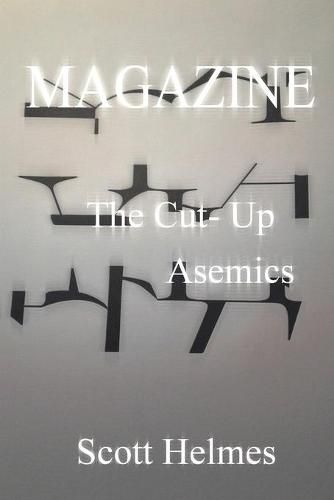Magazine: The Cut-Up Asemics
Scott Helmes

Magazine: The Cut-Up Asemics
Scott Helmes
Where does the text go after it’s been read? Pure Asemic writing is the total dissolution of the text, leaving traces of the human hand. These works occupy the space between the initial visual text and the pure asemic result. Initially taken from print magazines, primarily selected for the text and typography forms, these works are visual/concrete states of the above process.They reflect memory loss, partial comprehension of meaning and non-verbal sensory input. These too will evaporate at varying rates, depending upon how they are inputted and the ‘reading’ by the viewer. The additional element of what appears to be motion/movement represents the active role of physical writing, the passage of time and loss of meaning. The works start when Helmes finds magazines with interesting type styles. He works primarily with black printing as he feels color is an intrusive meaning, and then tears out selected pages as a first step. India ink is then applied to blank 8-½ x 11 plain, paper using either a palate knife or a rubber eraser. The ink-marks are done in a free style writing motion that does not follow the typical typesetting grid. After an over-all ink image is finalized, the magazine pages are torn up into individual elements that are placed on the page and within the frame work of the ink marks. The original meaning of the type is then altered and loses its references. The type then becomes suggestive, especially when the various forms are placed in new relationships with other ‘letters’. Usually attached to the ink lines, the letters begin their total dissolution into nothingness. Without the reader being able to reference the original text, the reader brings to the process their ideas/thoughts about what the text ‘says’. Sometimes whole words or groups of words are included, but these are selected based wholly upon a visual need as opposed to making language sense. Helmes feels these works become after-images and extend the reading and memory process to a unique form and retinal image that is tacked on whatever is left of the language memory. By now becoming a complete work, they extend the life of the magazine/text/writing, as opposed to just the memory of the textural meaning. Some of the early works were given the title of ‘Bones’, which is meant to convey language being stripped of the ‘flesh’ of the word and being left with absolute basics of its form. Later works are just dated and contain no further references, thus enabling a concrete point in the transition to Asemic writing
This item is not currently in-stock. It can be ordered online and is expected to ship in approx 2 weeks
Our stock data is updated periodically, and availability may change throughout the day for in-demand items. Please call the relevant shop for the most current stock information. Prices are subject to change without notice.
Sign in or become a Readings Member to add this title to a wishlist.

